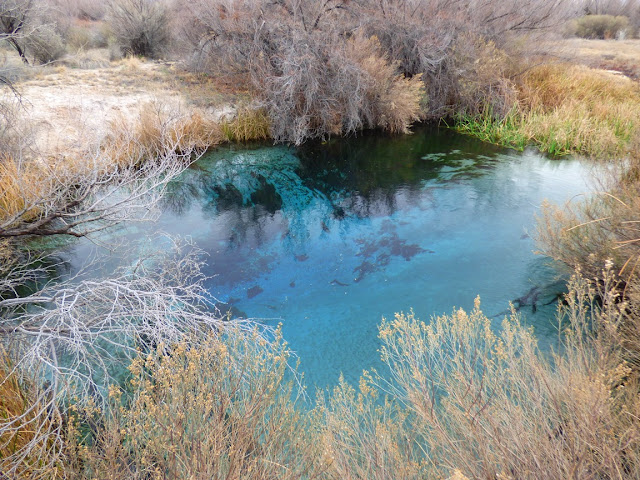 |
| Desert surrounds Ash Meadows, an unlikely oasis in western Nevada |
One such island is the oasis of Ash Meadows in western Nevada. Within the 37 square miles of the National Wildlife Refuge are (or were) nearly three dozen endemic species of plants and animals, species found nowhere else on the planet. They exist in this one isolated location because of the geology, which has funneled the groundwater of a vast region into a series of three or four dozen springs that emit tens of thousands of gallons per minute. Water in the desert is life. Lots of water in one spot of the desert is almost miraculous, and that is the situation at Ash Meadows.
 |
| The creek that flows from Crystal Spring. An ADA accessible boardwalk provides access |
The unique lifeforms found here include four living species of fish (along with one extinct species), eleven species of snails, three aquatic bugs, two species of bee, one extinct mammal (the Ash Meadows Montane Vole), and nine plant species.
 |
| "Ash" Meadows seems a particularly apt description of the region in winter |
 |
| Devil's Hole, home of the extremely endangered Devil's Hole Pupfish. The pool in the cavern opening is their only home. |
The refuge at Ash Meadows includes a single pool of water called Devil's Hole that contains the rarest fish species on the planet, the Devil's Hole Pupfish. The pool is an outlier of Death Valley National Park. Two other species of pupfish are found at Ash Meadows, the Ash Meadows Amargosa and the Warm Springs Pupfish. The Ash Meadows Speckled Dace is also found here. The Ash Meadows Killifish was driven to extinction in the 1950s as a result of spring alteration and agricultural development.
 |
| King's Spring can also be visited by an ADA accessible boardwalk. |
It is remarkable that Ash Meadows ever came to be a protected ecosystem because water in the desert attracts another species, one capable of altering the landscape and erasing from existence the other species that have survived in isolation for tens of thousands of years. The water at Ash Meadows caught the attention of desert travelers more than a century ago, and the water was used to irrigate alfalfa fields and other crops. Many of the springs were put into piping systems and numerous invasive species arrived to compete with the native ones. It's hard to believe, but as recently as the 1980s, a proposal to build casinos, strip malls, and 30,000 houses almost became a reality.
If you have visited Ash Meadows in the past, you will find some major changes. A marvelous new visitor center opened only a few months ago. There was plenty of excellent information about the geology and biology of the refuge, but I was especially impressed with the paleontology exhibits. Entire walls are devoted to a creative diorama of the fossil species found in the region, including the ancient billion year old animals as well as the various waves of Homo sapiens throughout time.
 |
| Western Kingbird at Point of Rocks in Ash Meadows |
To wrap up, have a look at an Ash Meadows Amargosa Pupfish defending its territory at Longstreet Spring. These are fascinating creatures, and true survivors. In our next post we'll drive through a mountain range. Not over, but through...
This is a highly abridged version of a blog I did on Ash Meadows last year. I've included pictures of our latest trip.




No comments:
Post a Comment